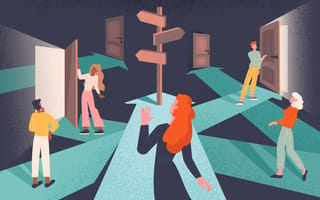You’re walking a tree-lined path in a location that hasn’t been disclosed to you. It’s getting dark and there are signs that keep pointing you in directions you’re only vaguely thinking you need to go. There’s an end point somewhere. But before you reach it, do you take a left or a right?
Now let’s apply this uncertain journey to the experience of using a product for the first time. How would you approach the path differently? What guideposts would you be seeking?
In the chaos and confusion of making a decision, it’s easy to get lost. Imagine finding guidance along the way from someone who knows you’re overwhelmed. Someone who notices you’re avoiding every left turn. Someone who says, “I see you’re scared; let’s go this way.”
This is where product design teams come in.
Regardless of industry, there is no user without the person behind it — the emotional processes, life experiences, and medical or financial decisions that make each of them who they are, and in turn, determine how they navigate difficult paths. The key to building a successful user journey is in understanding individual realities and the unique experiences they’re built upon.
In order to tap into the mindset of the user, analyze the various behaviors, reactions and decisions occurring on the other end of the line. Visualize the journey the user might take as they interact with the product. Consider what might make a decision easier or how a process could be simplified. Tell the user what their next steps should be to reach that end point, and offer them guidance, clarity or customized options along the way.
In other words: Be your user’s flashlight on that path in the dark.
For these three NYC tech leaders, the user is at the forefront of every decision made behind the scenes. By placing their teams on hypothetical paths through the user’s point of view, tapping into the emotional barriers of a decision and tailoring the experience from start to finish, they’ve each managed to map out journeys that benefit both their teams and the user.
Briefly describe your product’s user journey. What is your typical user’s first touchpoint with your product?
Patients are at the core of Cedar’s overall mission. There are two main segments of the patient journey where they interact with their provider through the Cedar product: before their visit when they are preparing to receive care, and after their visit when the bill for the care they received is ready.
The first pre-visit touchpoint is when a patient receives an appointment reminder for a visit they have booked. They are prompted to check in online via Cedar to save time during their visit. Patients can often feel anxious or fearful before receiving care, so we make it as easy as possible for them to update their contact and insurance information, fill out registration forms, and even make copayments, all online.
After a patient has received their care and leaves the hospital or doctor’s office, the next touchpoint is when they receive their bill via email, text or mailed paper statement. This can be one of the most stressful moments in a patient’s healthcare journey, and we try to solve for this by providing a simple, transparent and empathetic billing experience.
Visualizing the phase of the patient’s journey before and after they receive their bill led us to realize we needed to add more empathetic and helpful language.”
When building a user journey map, what are some best practices that your team always adheres to? Why are they important?
We ask, “Whose journey is it?” When dealing with a diverse user population, be specific. While there may be standard phases for multiple user archetypes, they also might experience each phase differently and require the product to respond accordingly.
A complicated user experience can have multiple journeys within it that need to be articulated. It’s important to keep it simple. We also look beyond touchpoints to understand the holistic nature of the user journey.
Finally, we want to make it usable and shareable by creating a journey map that is a detailed and multidimensional representation of the user’s experience.
Describe how a fleshed-out user journey map altered how you conceived of the design for one of your products in the past.
When we illustrated how we communicate and remind users to pay their bill and how certain patients were reacting, we saw in the data that patients without insurance and with a high balance were less likely to engage with a Cedar bill or subsequent bill reminders. When we mapped out the journey, we included the phase before a patient receives a bill, where they have left the hospital and have likely forgotten about their bill as they focus on their recovery. Medical bills can take months to deliver, and when they arrive, the patient is often surprised and anxious about how they will resolve them, especially when they are not covered by insurance.
Visualizing the phase of the patient’s journey before and after they receive their bill, as well as adding dimensions like emotion to our understanding of their experience, led us to realize we needed to add more empathetic and helpful language into our communications. We have run multiple experiments with patients who have high balances where we meet them in that panicked state by acknowledging it and surfacing different options that might help them, like payment plans.
Briefly describe your product’s user journey. What is your typical user’s first touchpoint with your product?
Clickotine is a clinically validated, fully digital smoking cessation program. People coming into Clickotine could be new or seasoned quitters, or just looking to maintain their smoke-free status. We recommend quit plans based on a user’s smoking history, nicotine dependence and personal goals. Upon selecting a quit plan, we prepare users for their quit day with daily missions, tools to manage cravings, advice from care guides and nicotine replacement therapy. To ensure a successful quitting experience, we’re there every step of the way to provide withdrawal and relapse support for users once they reach their quit day.
When building a user journey map, what are some best practices that your team always adheres to? Why are they important?
At Click, we create products for people with unmet medical needs, so it’s important to understand the user’s disease state and emotional journey alongside their actions in the app. To translate our vision, Click product managers utilize user journey maps as a lightweight, consumable representation of the digital product that an agile team can begin thinking collaboratively about. Being patient first, we supplement the user journey with insights from our clinical learning studies to relay the patient’s point of view and base the user journey in reality.
Click PMs use the following framework to map a user journey:
- Segmentation: Divide your user journey into phases to understand the stages they are going through.
- Actions: Understand which key high-level tasks the user does in each phase.
- Touchpoints: What part of the service or application do users interact with, and what steps do they take?
- Customer thought: What is the user thinking about? At this point, any user quotes or user research findings would help to enrich the map.
- KPI: Collect and highlight the baseline data to quantitatively understand the user’s current behavior.
How do you leverage the user journey map framework to continuously improve your product? What are your next steps?
Coming off of the framework above, we identify opportunity areas for design and engineering. What can we do better for the user that aligns with our North Star goal? We also leave room for open questions: What are the unknowns? What do we need more context into, technically or otherwise? What can we find out from our users?
Those second-level steps translate to epics in our agile product backlog, and eventually into more detailed user stories rooted in the pain point the user is facing. User journey maps are constantly evolving as we learn more about our users, and Click product managers constantly leverage clinical guidance, user research and scientific findings to inform the therapeutic and product journey.
Briefly describe your product’s user journey. What is your typical user’s first touchpoint with your product?
Reach Financial’s customers engage with our brand as they look into ways to achieve specific life goals where finances play a crucial role. Sometimes this means the customer is looking to optimize their credit card debt and they’re researching debt restructuring, consolidation or refinancing options. Other times it means they’re looking for ways to finance a major life event, such as a home remodel, vacation trip or wedding.
When building a user journey map, what are some best practices that your team always adheres to? Why are they important?
Building a user journey map starts with understanding our audiences at a fairly granular level. Step one is to segment our audience into specific personas. Doing proper research to determine who is behind the purchase decision is paramount. Our user experience teams dig into behavior traits, purchase obstacles, mindset, technology familiarity and a multitude of other dimensions to derive the right set of personas. Insights coming out of these persona mapping exercises fuel everything we do, from marketing copy to feature prioritization to how we label fields on our loan application.
Doing proper research to determine who is behind the purchase decision is paramount.”
Describe how a fleshed-out user journey map has altered how you conceived of the design for one of your products in the past.
Seeing the entire user journey end-to-end allowed us to make content personalization decisions when it came to how well our customers understood our products. We determined that some personas at certain stages in the user journey became overwhelmed with the amount of information they needed to absorb to make a decision. To address this information overload state, we introduced a feature called Personalized Video. Our system automatically delivers a short video, specific to the customer, to walk them through exactly what information they need to pay attention to and what decisions they need to make in a highly interactive and digestible way.











